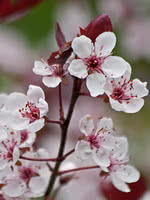Mon-Fri 9am - 5pm Mountain time
Purple Leaf Sand Cherry vs Wild Snowberry
Prunus x cistena
Symphoricarpos spp.
CUSTOM GROW
CUSTOM GROW
Purple Leaf Sand Cherry provides bright reddish-purple leaves that turn bronze-green in the fall. In the spring, tiny flowers with a pinkish white hue bloom. The flowers are small, but the impact comes from the shrub blossoming all at once.
The Purple leaf sand cherry can be susceptible to pests and diseases in more humid areas; a typical life span is approximately 15 years. Not suitable for a privacy hedge on its own but is often alternated with lilacs. Often used as an accent plant that attracts birds and bees.
Wild Snowberry is a mix of Common Snowberry and Western Snowberry. Each shrub's size, flower, and berry colour may vary.
This plant is abundant across the prairies. It can be planted alone or as a hedge in small yards. This shrub's ornamental berries persist into winter. Wild Snowberry can be a natural habitat and food source for various animals.
Purple Leaf Sand Cherry Quick Facts
Wild Snowberry Quick Facts
Toxicity: the leaves and seed are slightly toxic

